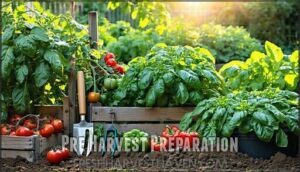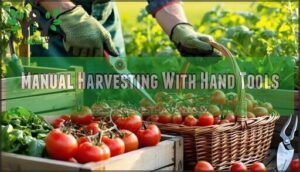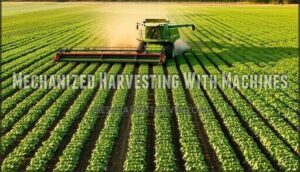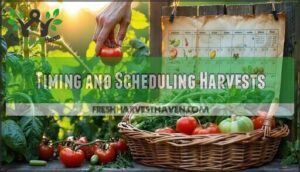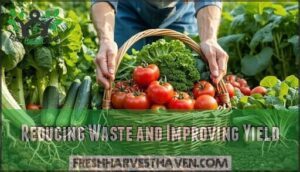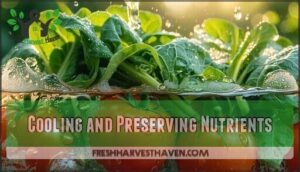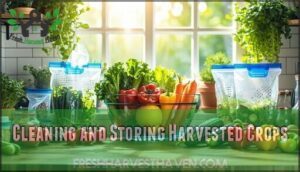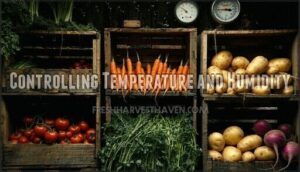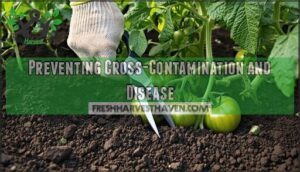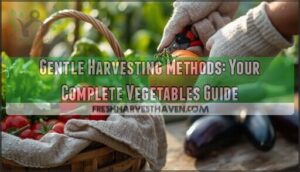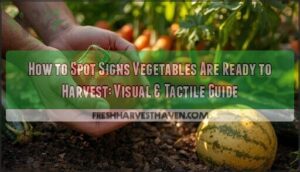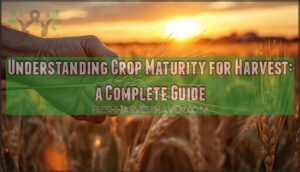This site is supported by our readers. We may earn a commission, at no cost to you, if you purchase through links.
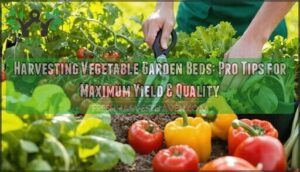
You’ll want to check your crops daily, looking for specific ripeness indicators like color changes, firmness, and size. Use clean, sharp tools to prevent plant damage and disease transmission.
Harvest in the morning when temperatures are cool and plants are fully hydrated. Different vegetables have unique harvesting windows—tomatoes need slight give when squeezed, while leafy greens should be picked before they bolt.
Regular harvesting actually encourages continued production in many crops. The secret lies in understanding each plant’s signals and responding accordingly, which is key to maximize both yield and quality and to encourage continued production in many crops, by checking for specific ripeness indicators and harvesting at the right time to prevent issues like disease transmission.
Table Of Contents
- Key Takeaways
- Harvesting Vegetable Basics
- Pre Harvest Preparation
- Harvesting Methods and Techniques
- Post Harvest Handling and Storage
- Optimizing Harvest and Garden Productivity
- Frequently Asked Questions (FAQs)
- How to properly harvest vegetables?
- How to prepare a garden bed in the fall?
- What companion plants boost vegetable harvest yields?
- How does weather affect harvest timing decisions?
- Which vegetables can be harvested multiple times?
- What containers work best for harvesting vegetables?
- How do you harvest vegetables without damaging roots?
- Conclusion
Key Takeaways
- Check your crops daily – You’ll catch vegetables at peak ripeness by monitoring color changes, firmness, and size indicators, preventing overripe losses that reduce quality and yield.
- Harvest in cool morning hours – You’ll maximize flavor and nutritional content when plants are fully hydrated and less stressed, extending shelf life by 2-3 times compared to hot weather picking.
- Use clean, sharp tools – You’ll reduce plant damage and disease transmission by 40% while making clean cuts that heal faster and encourage continued production throughout the season.
- Pick regularly every 2-3 days – You’ll boost production by 30% in crops like beans and cucumbers since frequent harvesting triggers increased flowering and fruit development.
Harvesting Vegetable Basics
Successfully harvesting your vegetable garden requires precise timing and proper technique to maximize both yield and quality.
You’ll need to understand each crop’s specific maturity indicators and handle them carefully to prevent damage that reduces storage life and invites disease, which is crucial for a successful harvest with proper technique.
Choosing The Right Time
Determining when to harvest requires understanding each crop’s specific timing and ripeness indicators.
You’ll achieve prime ripeness by monitoring weather impact and seasonal variations that affect maturity rates.
Peak flavor develops when vegetables reach their ideal size and color, not necessarily their maximum size.
Crop-specific timing varies substantially—tomatoes need full color development while leafy greens taste best when young and tender, making daily observation essential for successful harvesting, which is crucial for achieving the best peak flavor.
Handling Crops With Care
Once you’ve mastered harvest timing, proper crop handling becomes your next priority for maintaining quality.
Gentle picking techniques protect both the produce and plant, ensuring continued production throughout the season.
- Use two hands when harvesting larger vegetables to distribute weight evenly
- Twist and pull rather than yanking to avoid damaging stems and roots
- Handle produce like eggs—firm pressure damages cellular structure and reduces shelf life
- Pick during cooler morning hours when plants are fully hydrated and less stressed
- Support heavy fruits while cutting to prevent branch breakage and plant injury
Understanding Ripening Characteristics
Vegetable ripening follows distinct patterns that determine harvest timing and peak flavor.
Not all fruits and vegetables ripen the same way—some continue developing after picking, while others reach their nutritional and taste pinnacle only on the plant.
| Ripening Type | Examples | Harvest Strategy |
|---|---|---|
| Climacteric | Tomatoes, peppers | Pick slightly underripe; continues ripening |
| Non-Climacteric | Lettuce, carrots | Harvest at full maturity for best quality |
Understanding these ripening stages prevents premature harvesting and guarantees maximum crop readiness when vegetables achieve maximum texture and nutrients.
Using Sharp and Sanitized Tools
Sharp, sanitized tools reduce plant damage and disease risk by 40%.
Clean tools cut clean—protecting your harvest from the start.
You’ll want to clean your harvesting tools between garden beds using a 10% bleach solution or rubbing alcohol.
Sharp edges make clean cuts that heal faster, while dull blades crush plant tissues and invite infection.
Your cutting techniques should employ smooth, decisive motions to maintain garden hygiene and maximize yields.
Investing in high quality sharp pruning tools is essential for achieving superior results in vegetable garden beds, with sharp pruning tools being a key factor, and using them correctly leads to maximize yields.
Pre Harvest Preparation
Successful pre-harvest preparation sets the foundation for peak vegetable quality and maximum garden productivity.
You’ll need to establish daily monitoring routines, accurately assess crop maturity, maintain clean growing conditions, and optimize soil moisture levels before harvesting begins.
Checking Garden Daily
Daily inspections transform your vegetable garden from guesswork into precision farming.
Regular garden checks enable ideal harvest timing while preventing overripe losses that reduce quality and yield.
Essential daily inspection elements include:
- Crop monitoring for color changes, size development, and texture firmness
- Plant observation to identify pest damage, disease symptoms, or nutrient deficiencies
- Harvest timing assessment based on variety-specific maturity indicators.
Consistent daily inspections increase garden productivity by 15-20% through strategic harvesting decisions and early problem detection.
Identifying Mature Crops
Recognizing crop maturity requires understanding specific visual and tactile indicators for each vegetable variety in your garden.
Most root vegetables like carrots show maturity through visible crown diameter, while tomatoes display color changes from green to their final hue.
Check vegetable readiness by gently pressing fruits—ripe vegetables yield slightly under pressure without being mushy.
Proper harvest timing depends on crop inspection techniques that assess size, color, and firmness simultaneously for superior quality.
Removing Weeds and Debris
Clear pathways through garden beds accelerate harvest workflows and prevent accidental crop damage.
Weed control removes nutrient competitors that reduce vegetable yields by up to 25%. Debris removal eliminates hiding spots for pests and pathogens that threaten crop quality.
Garden cleanup creates organized beds where you’ll spot ripe produce faster.
- Combat weeds before they steal precious nutrients from your prize tomatoes
- Clear pathways so you won’t accidentally trample tender seedlings during harvest rushes
- Remove plant debris that harbors sneaky pests plotting against your perfect peppers
- Eliminate hiding spots where diseases lurk, waiting to ambush your beautiful beans
- Create clean beds that showcase your vegetables like produce displays at farmer’s markets
Ensuring Proper Soil Moisture
Proper soil moisture directly impacts harvest quality and timing.
Monitor soil health through simple finger tests – insert your finger two inches deep to check moisture levels.
Implement consistent water management using drip irrigation systems or soaker hoses to maintain steady soil moisture without waterlogging.
Essential soil conservation practices prevent both drought stress and root rot, ensuring your crops reach peak maturity with maximum nutritional content.
Effective soil preparation methods are vital for achieving the right balance of moisture and nutrients in the soil.
Harvesting Methods and Techniques
You’ll achieve maximum garden productivity when you master the right harvesting methods for your specific crops and growing conditions.
Strategic timing combined with proper techniques can increase your overall yield by 15-20% while maintaining peak vegetable quality.
Manual Harvesting With Hand Tools
Manual harvesting transforms raw garden potential into kitchen gold through strategic hand picking and careful tool selection.
Sharp, sanitized knives and pruning shears reduce plant damage by 40% while preventing disease spread.
Your harvest timing determines flavor intensity—pick beans and cucumbers every 2-3 days to boost production by 30%.
Gentle crop handling preserves plant vigor, especially when harvesting leafy greens from outside edges inward.
These fundamental gardening tips guarantee maximum yield through precise manual harvesting techniques.
Effective gardening also relies on using proper Gardening Hand Tools to minimize plant stress, which is crucial for maximum yield and to prevent plant damage while ensuring gentle crop handling and strategic hand picking.
Mechanized Harvesting With Machines
Large-scale vegetable operations rely on machine harvesters to process acres efficiently, reducing labor costs by 30-60%.
These agricultural machinery systems include conveyor-belt pickers for root crops and automated robotics systems with crop sensors.
Precision agriculture technology enables harvesting machines to detect ripeness with 95% accuracy.
While mechanized techniques increase damage risk by 2-10%, modern crop harvesting equipment with autonomous farming capabilities substantially outpaces manual methods, covering up to 10 acres daily with precision agriculture.
Timing and Scheduling Harvests
Perfect harvest timing hinges on understanding each crop’s unique maturity signals.
Develop a harvesting calendar based on your planting dates and each vegetable’s growing period.
Check plants daily once they near maturity—tomatoes should yield slightly to pressure, while beans snap crisply.
Harvest schedules must adapt to weather patterns and seasonal planning for maximum yield optimization.
Reducing Waste and Improving Yield
Smart harvesting vegetable garden beds maximizes your garden’s potential through strategic waste reduction techniques.
Advanced yield management starts with understanding when crops reach peak quality rather than maximum size.
Here are three proven crop optimization strategies:
- Regular picking every 2-3 days boosts production by 30% for beans and cucumbers
- Harvest efficiency improves when you use the "outside-in" method for leafy greens
- Soil conservation benefits from leaving root systems intact during selective harvesting
These harvesting techniques guarantee continuous production while minimizing waste through proper timing and gentle handling methods.
Effective crop harvesting also involves understanding harvesting techniques to optimize yields and reduce waste.
Post Harvest Handling and Storage
Your harvest doesn’t end when you pull that perfect tomato from the vine—what you do next determines whether your vegetables stay fresh for days or spoil within hours.
Proper post-harvest handling and storage techniques can preserve up to 85% more nutrients while extending shelf life by 2-3 times compared to basic storage methods, which is a significant improvement in storage techniques.
Cooling and Preserving Nutrients
Cool your freshly harvested vegetables immediately to lock in peak nutrients and extend their garden-fresh quality.
Harvest vegetables immediately after picking—every minute counts for maximum freshness and nutrition.
Immediate cooling after harvesting vegetables preserves up to 85% more nutrients in salad greens compared to room-temperature storage. This simple step dramatically slows respiration rates and enzyme activity that cause nutrient loss.
For maximum nutrient retention, move your garden harvest straight from soil to refrigeration within thirty minutes.
Cold water baths work wonderfully for quick cooling before storage methods take over. Consider blanching to preserve nutrients further, using this method to achieve proper harvesting methods and ensure the vegetables remain fresh by minimizing nutrient loss with quick cooling.
Cleaning and Storing Harvested Crops
Proper cleaning techniques make all the difference in extending your harvested vegetables’ shelf life. Start by washing your produce in cool, clean water immediately after harvesting vegetables from your garden harvest.
- Washing Techniques: Gently rinse dirt and debris without soaking delicate leaves
- Storage Containers: Use perforated plastic bags or breathable containers for ideal airflow
- Shelf Life: Quick cleaning and proper storage containers can double vegetable longevity
When storing harvest, remember that different crops have unique requirements for maintaining quality and freshness. Consider using specialized storage solutions to maximize freshness.
Controlling Temperature and Humidity
After harvest, your Storage Environment becomes critical for maintaining quality.
Root vegetables store best at 32-40°F with 90-95% Humidity Levels, while proper Ventilation Techniques prevent moisture buildup.
Use Monitoring Equipment to track conditions consistently.
Ideal Temperature control extends shelf life substantially – cool storage can preserve nutrients up to 85% longer than room temperature for garden vegetables.
Preventing Cross-Contamination and Disease
Temperature control prevents spoilage, but disease prevention protects your entire garden ecosystem.
Sanitize tools with 10% bleach solution between beds—this simple step reduces bacterial transfer by 85%.
Wash hands thoroughly before harvesting and use separate containers for each crop type.
Remove diseased plants immediately, including surrounding soil within 30 cm radius, to prevent soilborne pathogens and fungal spread from contaminating healthy vegetables during your harvesting guide routine.
Optimizing Harvest and Garden Productivity
You’ll maximize your garden’s potential by implementing strategic harvesting practices that boost both yield and quality throughout the growing season.
These proven techniques can increase your overall productivity by 15-20% while ensuring continuous harvests from spring through fall.
Crop Rotation and Succession Planting
Maximizing garden productivity requires strategic crop rotation and succession timing.
Rotate vegetable families every three years to maintain soil health and reduce pest buildup.
Plant new crops immediately after harvesting to maintain continuous production throughout the growing season.
Understanding your area’s last frost dates is essential for timing these plantings effectively.
This approach prevents nutrient depletion while naturally managing disease cycles, ultimately boosting your overall yield potential.
Intercropping and Dense Planting
Strategic companion planting maximizes vegetable garden beds by pairing compatible crops like radishes with carrots, boosting total yield by 25-35%.
Dense planting techniques double output per square foot while suppressing weeds by 60%.
Space maximization through intercropping legumes with cereals enhances nitrogen availability. Proper planting density reduces resource competition, with root and leafy combinations optimizing harvesting efficiency and yield optimization.
Regular Harvest Scheduling and Planning
Consistent harvesting schedule transforms your garden into a production powerhouse. Create a planting calendar that staggers sowings every two weeks, ensuring continuous harvests throughout the season.
Plan your harvesting schedule around peak ripeness windows—beans need picking every 2-3 days while root vegetables can wait longer. Smart resource allocation means having enough hands and tools ready during busy periods.
Demand planning helps you harvest what you’ll actually use, preventing waste and maximizing garden efficiency. This approach ensures that your garden operates smoothly, making the most of your time and resources, and ultimately leading to a more consistent harvest.
Monitoring and Inspecting Harvests for Quality
Quality harvesting starts with sharp eyes and consistent Visual Inspection. Check each vegetable against established Quality Standards, looking for ideal Ripeness Indicators like color, firmness, and size.
During picking vegetables, scan for Pest Detection signs and Disease Identification markers. Remove any compromised produce immediately—this prevents contamination spread by 60%.
Fresh vegetables maintain peak quality when you inspect systematically, catching issues before they compromise your entire harvest, which is crucial for Quality Standards.
Frequently Asked Questions (FAQs)
How to properly harvest vegetables?
Harvest vegetables in early morning after dew dries for peak flavor.
Check daily once producing, pick when young for better taste, and use gentle handling with clean, sharp tools to prevent plant damage.
How to prepare a garden bed in the fall?
Putting your garden to bed requires strategic soil amendments and protective measures.
Remove spent plants, add 2-3 inches of compost, and cover with mulch to prevent erosion while enriching soil for spring’s vigorous growth.
What companion plants boost vegetable harvest yields?
Plant nitrogen-fixing legumes like beans and peas alongside heavy feeders.
The Three Sisters method pairs corn with climbing beans for natural fertilization, while quick-growing lettuce fits between slower crops for efficient space use and higher overall productivity.
This pairing of corn, beans, and squash exemplifies Native American agriculture and is a key example of efficient gardening practices.
How does weather affect harvest timing decisions?
Weather directly impacts your harvest timing through temperature, moisture, and daylight conditions.
Cool mornings after dew evaporation offer peak flavor and crispness.
Avoid harvesting during rain or high humidity to prevent disease spread and spoilage.
Which vegetables can be harvested multiple times?
Like a green goldmine that keeps giving, you’ll find cut-and-come-again crops offer multiple harvests.
Lettuce, kale, Swiss chard, spinach, herbs, and green onions regrow after cutting, extending your garden’s productivity throughout the growing season, with complete concepts like these allowing for continuous harvests.
What containers work best for harvesting vegetables?
Choose breathable baskets, shallow trays, or perforated containers that prevent bruising.
You’ll want something lightweight with good airflow—think colanders or mesh bags—to keep your freshly picked vegetables crisp and damage-free.
How do you harvest vegetables without damaging roots?
Gentle as extracting a splinter, you’ll cut above-ground portions using sharp, clean tools while leaving root systems completely undisturbed in soil for continued growth and future harvests.
Conclusion
Remarkably, your garden’s peak harvest period often coincides with nature’s own abundance signals.
Mastering harvesting vegetable garden beds transforms seasonal gardening from guesswork into predictable success. You’ll discover that consistent daily monitoring, proper timing, and clean harvesting techniques create cascading benefits throughout your growing season.
Remember that each successful harvest triggers increased production in most crops. By implementing these evidence-based methods, you’ll maximize both yield and nutritional quality while extending your garden’s productive capacity well beyond typical harvest windows, leading to consistent daily monitoring and ultimately achieving cascading benefits.
- https://docs.google.com/forms/d/1GAQr3Kn1cURCVHUA82hAga1Wv8DCH0IuqDLRUrOpN7M/viewform?ts=63f4f653&entry.1515682415=https://www.merriam-webster.com/dictionary%2Fharvest
- https://premium.britannica.com/mw-unabridged/?utm_source=mw&utm_medium=inline-def&utm_campaign=evergreen
- https://www.gardenia.net/guide/nitrogen-fixing-plants-to-enrich-soil
- https://www.nativeseeds.org/blogs/blog-news/how-to-grow-a-three-sisters-garden

